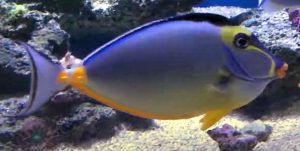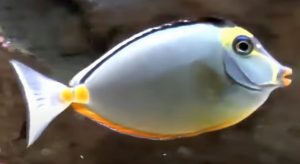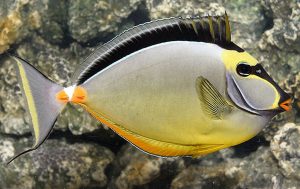The Naso Tang (Naso Lituratus) known to tropical fish keeping enthusiasts as Barcheek Unicorn, Clown Surgeonfish, Literate Surgeonfish, Lipstick Tang, Orangespine Unicornfish, and Barcheek Unicornfish is found in the East Indian and Pacific Ocean. Their extensive range in the central and western parts of the Pacific Ocean includes Hawaii, Japan, Tuamotu, and the Marquesas.
The Naso Tang is usually encountered swimming in pairs or in large groups, grazing on sargassum and dictyota above the corals and live rock found among the flats and outer slopes of the coral reefs, at depths from 15 to well over 300 feet.
Juvenile Naso Tangs have a dark gray body color, a blue stripe following along the dorsal fin, and an orange stripe in the anal fin.
As they mature a thin, black face mask outlined with bright yellow forms between the eyes and mouth, the lips develop a reddish orange (lipstick) color, the body morphs into a brownish gray color with a yellow nape and a broad black band on the dorsal fin, the tail acquires a lyre shape with a vertical yellow bar towards the posterior, and two bright orange patches develop at the two forward hooked spines on the caudal peduncle.
Males are slightly larger than females and develop trailing caudal streamers that the females lack. For reasons unknown, Naso Tangs collected from Hawaiian waters are more brightly colored.
Although the Naso Tang (Naso Lituratus) is sometimes misidentified as the Blonde Naso Tang (Naso elegans) found in the Indian Ocean; Naso elegans have predominantly yellow colored dorsal fins with some shades of black, compared to the dorsal fins of Naso Tangs which are predominantly black and gray.
Because adult Naso Tangs grow to almost 18″ in an aquarium environment, they are best housed in a mature FOWLR or reef tank of at least 180 gallon capacity with a crushed coral or coraline sand substrate, plenty of live rock arranged into large caves and overhangs, and plenty of free swimming space. They need high oxygen levels, strong currents in the tank, and pristine water conditions to thrive. An appropriately sized reef filtration system with a good protein skimmer and multiple power heads is recommended along with the normal water changes required in reef systems.
The Naso Tang is reef safe and will generally ignore corals and invertebrates in the tank. They are a shy, active, and somewhat nervous species that are peaceful with other fish in the tank but are aggressive towards most other tangs. Some good tankmates include clownfish, eels, gobies, yellow tang, sailfin tang, and angelfish. In larger aquariums of 200 gallon and over capacity, other tangs like the Purple Tang can be safely housed with Naso Tangs.
In a reef tank, Naso Tangs benefit greatly from cleaner wrasses, cleaner shrimp, or neon gobies that remove any parasites from their skin. They also lack a mucus barrier on their bodies which makes them susceptible to marine ich and velvet. Cryptocaryon is very common among tangs but is easily cured with copper drugs in a quarantine tank.
Because of their large size, Naso Tangs have not been bred in a home aquarium environment. It is possible, but a huge tank would be required. In their natural habitat Naso Lituratus display the egg scattering spawning activity typical of the family Acanthuridae. They are pair spawners. After a brief courtship ritual, the male and female swim up into the water column to the surface where the female releases her eggs and the male immediately fertilizes them. The planktonic eggs drift with the current along the surface until they hatch. The finless fry live off the yolk sack until completely absorbed, at which point they drift to the bottom of the reef feeding on microalgae until they grow into juveniles. Spawning occurs year round in Guam.
Adult Naso Tangs thrive on a diet of wild algae, with a definite preference for brown macroalgae. In the wild, they normally eat sargassum and dictyota. In an aquarium environment, they should be copious amounts of dried seaweed or dried algae. A lettuce clip placed under some live rock in the tank is a good way to introduce the seaweed. The key to keeping the Naso Tang healthy in the long term is to obtain some brown macroalgae to feed them, which is by far the most natural thing for them to eat.
Unique to members of Acanthuridae, including the Naso Tang, is the epulopiscium bacteria in their gut which influences their digestion. Candidatus Epulonipiscium is a genus of Gram positive bacteria that have a symbiotic relationship with surgeonfish and helps them process this algae in their diet.
In a pinch, Naso Tangs will eat Mysis shrimp, brine shrimp, and other meaty foods when they see other fish eating, but these foods should not become a staple. Herbivore preparations like Sea Veggies
, Seaweed Salad, and Ocean Nutrition are all good products that are very easy to use as a substitute.
The Naso Tang (Naso Lituratus) is commonly available to tropical fish keeping enthusiasts from specialty fish shops, online wholesalers, retailers, and trans shippers at the following approximate purchase sizes from several areas in the Indo Pacific: Small: 1″ to 2″; Small/Medium: 2″ to 3″; Medium: 3″ to 4″; Medium/Large: 4″ to 6″; Large: 6″ to 8″; Extra Large: 8″ to 9″. Prices vary depending on locale and size but start at around $179.00 for medium adults.
Minimum Tank Size: 180 gallons
Aquarium Type: Reef or FOLR
Care Level: Moderate
Temperament: Semi Aggressive
Aquarium Hardiness: Hardy
Water Conditions: 75-79° F, dKH 8-12, pH 8.1-8.4, sg 1.020-1.025
Max. Size: 18″
Color Form: Black, Blue, Orange, Red, Yellow
Diet: Herbivore
Compatibility: Reef
Origin: East Indian and Pacific Ocean
Family: Acanthuridae
Lifespan: 8+ years
Aquarist Experience Level: Intermediate





These article is very helpful to me.
Can I get the authors name for this article?
Speaking…..